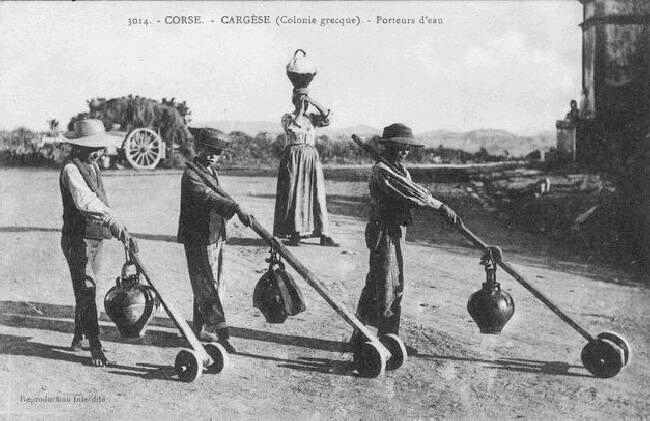
French Boys Clothes: Activities--Work

Figure 1.--The postcard here shows water carriers in a Greek colony in Cargèse, a village on western coast of Corsica, 50 km from Ajaccio. The postcard is undated, but we would guess was taken about 1905. Note the long pants the boys wear. Poor working-class boys at the time were more likely to wear long pants than the more fashionable knee pants.
|
|
We do not yet have much information about French boys working. France in the 19th century had the same problems associated with child labor as oyher countries as they industrialized. These are best known in England because of Charles Dickens, but similar problems were experienced in other countries such as France. France was not as industrialized as England, but with the advent of the Third Republic (1870), it had a reformist Government which addressed a range of social issues. We are not familiar yet, however, with the efforts in France to regulate child labor. We believe that the problem was addresses sooner in France than in Britain and America, but do not yet have the historical details. The French children most likely to work in the 20th century, as in other countries were children in rural areas who worked on family farms or estates. We note similar parterns with communications messenger boys as we note in most other countries. An image of a French telephone exchange that the operators were women, but there appears to be a uniformed messemger boy. Hopefully French readers will provide us some details about child labor in France.
We do not yet have much information about French boys working. France in the 19th century had the same problems associated with child labor as other countries as they industrialized. These are best known in England because of Charles Dickens, but similar problems were experienced in other countries such as France. France was not as industrialized as England, but with the advent of the Third Republic (1870), it had a reformist Government which addressed a range of social issues. We are not familiar yet, however, with the efforts in France to regulate child labor. A French reader writes, "The scandals about children working in the mines and manufacturing factories in the 19th century resulted in several laws passed by the Government as well as the adoption of educational reforms. By the late-19th century French children 6 to 12 years of age were required to attend school as a result of compulsory attendance laws. If they worked outside schooltime, it might be simple, occasional work such as shining shoes and above all not dangerous mine and factory work. Still in the 1890s, there were some manufaturers that illegally employed children less 13 years of age. They took the risk of being exposed by he labor inspection ( Inspection du travail ). Here is a 1892 example pf a police's inspector report about a manufacturer sanctionned for employing six boys less 13 years old." We note an 1848 labor law, but do not yet have any details about it.
The only specific law we have noted is the Jules Ferry Act (1882). We also notice a 1892 law, but again have no details. Closely related to child labor laws is the establishment of a public school system and compulsory attendance laws. We believe that the problem was addresses sooner in France than in Britain and America, but do not yet have the historical details.
Work Areas
It was still very commin forbboys to mwork in the 19th century. And this involved may different work areas. We note a 1866 oil on wood panel was painted by French genre artist Pierre Jean Edmond Castan. He Depicts a new cabin boy on the deck of a ship. Ships at the time were still mostly sai ships. The boy is looking back at the port and home he has just left, presumably waving goodbye to his mother. He wears what looks like two shirts, awhite shirt and a heavier red shirt. His pand are wide and naggy. There is another cabin boy at the left side with an older man smoking a pipe. Many of Castan's paintings feature children, sometimes in bitter-sweet situations like this one. The French children most likely to work in the 20th century, as in other countries were children in rural areas who worked on family farms or estates. Older boys might find work as messengers. We note similar parterns with communications messenger boys as we note in most other countries. An image of a French telephone exchange that the operators were women, but there appears to be a uniformed messemger boy. Here we see water carriers on Corsica (figure 1).
HBC

Navigate the Boys' Historical Clothing Web Site:
[Return to the Main French activities page]
[Return to the Main country work page]
[Introduction]
[Activities]
[Biographies]
[Chronology]
[Countries]
[Clothing styles]
[Bibliographies]
[Contributions]
[FAQs]
[French glossary]
[Images]
[Links]
[Registration]
[Tools]
[Boys' Clothing Home]
Navigate the Boys' Historical Clothing French pages:
[Return to the Main French page]
[French choirs]
[French school uniforms]
[French school smocks]
[French royalty]
[French sailor suits]
[French scout uniforms]
[Difficult French images]
[French art]
[French Movies]
[French ethnics]
Created: 9:50 PM 1/28/2006
Last updated: 4:28 PM 3/15/2012



